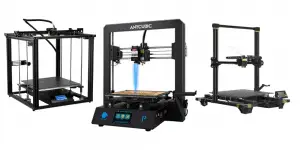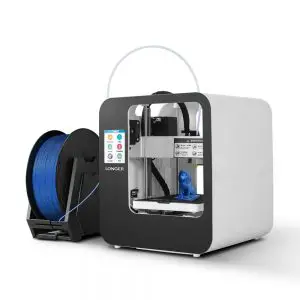You may have heard of 3D printing before in the news, but it’s not as well-known and understood as other technologies like smartphones. Despite this, innovation and research with 3D printers has been going underway in recent years, and such developments are changing the way how our world designs, builds, and uses “stuff.” Similar to how the internet changed how we access information, 3D printing is beginning to change how we design and build objects, tools, and other useful things.
What Exactly is 3D Printing?

Printing is, by definition, the reproduction of material, like books. When you print your essay or resume off your computer, you’re bringing your material from the digital world and into the physical world. This is exactly what 3D printing does. 3D printing is the reproduction of digital material into the real world, not as a flat piece of paper but a physical item.
It may sound a little science fiction-y, but the concept of 3D printing isn’t too complicated to grasp. 3D printers use special computer software to design just about anything you can imagine. The blueprint is printed out in a 3D printer with the appropriate material layer by layer, also known as additive manufacturing. A carriage (part of the 3D printer), runs over its support bars, and the extruder(s) pipe out bits of the material. It’s certainly a neat process to watch, and there are plenty of videos out there to give you a visual of the process.
You may have seen or heard of 3D-printed plastic toys or small tools, but some 3D industrial printers are designed to use other materials for different purposes, such as concrete or metal. In this article, we’re focusing on the application of 3D printing outside of the commonly seen production of small toys and gadgets for domestic use.
3D Printing & Food
You mightn’t have expected to see food written in an article about 3D printing, but it’s true! 3D printing technology has been used to make food products. Instead of using plastic or some other manufacturing material, 3D food printers can use soft or liquid foods like (melted) chocolate, cheese, food dyes, sauces, and much more to make something delicious. Think of all the cool chocolate sculptures you could make with a 3D printer!

Not everything that a 3D printer could make is sugary though. 3D food printing can be put to good nutritional use too. There has been interest in using these machines to make higher-quality foods for seniors and other people who need to eat softer things. A 3D food printer could make food that is not only nutritionally balanced, but also appetizing for people who cannot chew or swallow well, ensuring they get the stuff their bodies need. This technology could improve the quality of life for countless people.
There has also been research into making lab-grown meats using 3D printers. A small sample of muscle cells taken from an animal can be cultivated and grown in a lab, and 3D printer could shape those muscles into a hamburger or some other cut of meat like a chicken breast or steak.
The benefits of 3D printing food also include the reduction of food waste. Processing less choosy cuts of meat or undesirably shaped (but just as tasty) fruits and vegetables through 3D printing means we could produce high-quality and nutritious food. This would not only cut the costs of food production, but also reduce food waste and lower our ecological footprints. Using less land, water, and farm equipment can positively affect human influence on the environment.
3D Printing & Construction
3D printing can be used in the building and design of houses with large 3D printers. In fact, it already has been done!
In 2014, a Chinese company called WinSun designed and built 10 detached, single-story 3D printed houses in a day. Large 10 x 6.6-meter 3D printings accomplished the job by extruding a cement and construction waste mix and forming the houses’ walls. The great thing about this building method is that it’s cheap and less labor-intensive than traditional construction. The 3D printed houses WinSun built cost about $5,000 USD, and WinSun didn’t stop there. A year later, WinSun unveiled their 3D printing apartment block consisting of five stories. This massive project cost $161,000 USD, and WinSun used a mixture of “glass fiber, steel, cement, hardening agents, and recycled construction waste” to print parts of the building, which were later assembled at the construction site. This proves 3D printing can serve as a viable way for safe, secure, and affordable housing to be built today and in the future.

Other people have been experimenting with 3D printing construction as well. In the spring of 2019, Dr. Paul Tinari, a scientist in British Columbia, Canada, demonstrated his concrete 3D printer. Dr. Tinari’s 3D printer can build the outer shell of a 4-bedroom home within 24 hours. This 3D printer builds the concrete shell fully assembled, unlike WinSun’s that are more akin to prefabricated homes. Whether 3D printers build the house shell together or parts ready-to-assemble, the architectural possibilities with 3D printing are sure to become a growing and even more exciting part of construction in the years to come.
3D Printing in Medicine
It could be argued that 3D printing has provided the greatest benefit to human medical care. 3D printing offers a more efficient way of producing personalized medical equipment. 3D printing technology can help medical professionals prepare for difficult operations (such as this 2-year-old’s cranial surgery), or even make medical implants like replacement hip joints. Customized tools and equipment could become easier to make and more affordable for hospitals and researchers to use, improving patient care in the process.
Prosthetics

Prosthetics are customized to fit each and every individual a little differently. They require maintenance and need to be replaced/refitted every few years, especially for growing children and teens. This makes prosthetics (along with other customized medical equipment) expensive, and sometimes that cost is inaccessible enough that hundreds of thousands of people around the world go without. 3D printing prosthetics can be an excellent way to produce prosthetics. An example of this is the Victoria Hand Project in British Columbia (VHP). VHP makes custom-fitting prosthetics for people in 7 developing countries, though they are expanding their outreach within their home country of Canada to serve the needs of Canadian amputees and those with scoliosis in remote areas. Prosthetics can greatly increase a person’s quality of life, and we couldn’t think of a better way to use 3D printing for good!
Organs
Okay, so this is the most futuristic part of this article, well…besides the lab-grown meat.
Scientists are working hard at growing organs for medical use. Organs?!
How would this work? It starts with a 3D-printed model. A webbed “shell” of a body part, such as an ear, is printed with a special 3D printing machine (a bioprinter). The bioprinter has multiple extruders for different materials. One of these extruders contains a bioplastic material to build a webbed shell of the body part, while the others could be filled with proteins and a patient’s cells. This would encourage the cultivated cells to grow in and around the shell, forming an artificial body part with the patient’s own DNA. Of course, this organ-growing process is still in the research and development stage, but it’s sure to become a part of human medical care in the not-so-distant future.
The benefits of 3D printing organs solve the issues of organ donation. Organ donors have to be a proper “match” for the recipient. It can take time to find a donor, and not everyone can wait that long. Kidney and liver transplants can be done with living donors, but the operations required not only risk the recipient’s health, but also put the donor at risk. In the end, organ recipients have to take medication to prevent their bodies from rejecting the organ.
Organ donation saves lives, but it’s time-consuming and risky. Being able to grow organs would be a major game-changer in human health. An organ could be grown when needed with the patient’s own cells, making their bodies less likely to reject the new part. More people could lead happier, longer, and healthier lives with this type of 3D printing.
3D Printing In The Future?
What does the future really hold for 3D printing? We can’t predict the future, but we can make a good guess because the technology has been rapidly developing. Today, you can buy an average desktop-sized 3D printer online and have it shipped to your house for less than $300 USD. There are hobbyists designing and building little figurines, toys, and gadgets in their homes with 3D printers, and businesses are incorporating them into their production lines to make stuff cheaper and faster without sacrificing quality. 3D printing designs are available online for free or purchase like craft patterns. We really are living in the future, aren’t we?

The benefits of 3D printing are clear. Customized and affordable products, whether it’s the shell of a house or prosthetic arm, are possible with this technology. We’re sure to see 3D printing become increasingly important in the production of a variety of goods, flipping the idea of what it means to manufacture things on its head.
Maybe someday, you or a loved one will receive a 3D-printed kidney grown with their own cells, keeping them off a waiting list and weekly dialysis. Wouldn’t that just be the most amazing thing?




